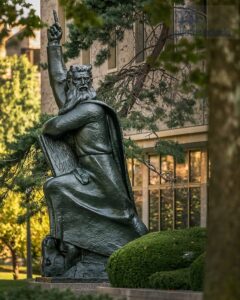Commentary:
It’s instructive that the season of Epiphany, which begins with a bright star in the East, leading the Magi to worship the Christ-child concludes with Transfiguration Sunday, in which glory and shining, brilliance and light are, again, prominent themes. This imagery would have been at home in the Ancient Near Eastern imagination as, according to Robert Alter, “The notion of divine radiance enveloping the head or face of a god, a king, or a priest appears in numerous Mesopotamian texts, and so would probably have been a familiar idea to the ancient Hebrew audience.” There are a couple of theories about the theological import of Moses’ shining face when descending from his mountain top experience with God.
Moses and the word of God
Think about the various traditions associated with the reading of God’s Word in a church service. In one church I served, we stood for the reading of Scripture. In another, we ended our reading with: “The word of the Lord. Thanks be to God.” Sometimes we offer a prayer of illumination before the reading of Scripture and have the readers stand behind a pulpit or lectern. All of these are ways to highlight that this is, well, the highlight of our time together. This is a very specific place we meet with God through the word. According to Terence Fretheim, “The word is imaged in a shining, a radiance, a brilliance, an incandescence, a fieriness. As such, it evokes freshness, vividness, intensity, and splendor.” When we encounter the word of God, something special is happening in us and then through us.
Moses met with God, descended the mountain and something of that experience went with him into the world. So for us today, meeting with God in worship doesn’t end with the benediction or as you cross the threshold from the Narthex into the parking lot. Something of the experience of meeting with God is meant to go with us into the world. Again from Fretheim, “The human response can never simply be to believe or speak; it must also mean to do, to reembody the word in the world.”
Moses and the Word of God
Not only do we set apart the reading of God’s Word with various traditions, liturgical movements, etc. we also set apart the one who interprets Scripture. The pastor or preacher takes on a particular role among the assembled congregation as a mediator, a witness from one experience of the text into the lives of those who now hear the text. Again, in more formal liturgical traditions, such a one might wear a collar, robe or stole conveying a kind-of set-apartness of the one who mediates, brings God’s word to the people.
Fretheim relates the to Moses, “Moses is not simply a speaker for the word of God; in some sense he embodies that word. The people thus do not only hear that word being spoken, they see it standing before them. There is conveyed in Moses’ own body something of the nature of the divine communication to the community.” Moses is, of course, one of the primary sources in Hebrew Scripture for this kind of mediation. The glow that he exhibits in chapter 32 goes into the tabernacle in chapter 40, thus marking the set-apartness of the place of worship and the priests who facilitate the rituals on behalf of God’s people. This also explains the necessity of a veil, just as the Tabernacle, and later the Temple, required a heavy curtain, like a veil guarding the Most Holy Place, so too the glory on Moses face was hidden away.
Ultimately, Moses is also a type of the one Mediator, the Word made flesh. It is not a coincidence that the Lectionary pairs this reading with the story of Christ’s own Transfiguration. What Moses embodies, Christ incarnates. After all, one posture for the reading of Scripture not mentioned above is those traditions that move the reading of the gospel lesson into the center of the sanctuary, a reminder that Christ, set aside the privileges of heaven to enter into our world. His glory was subdued in his earthly appearance so that he could mediate to us and, eventually, carry human flesh back into heaven to be with God.
[Note: In addition to these weekly sermon commentaries on the CEP website, we also have a resource page for Lent and Easter with more preaching and worship ideas as well as sample sermons on the Year C Lectionary texts.]
Illustration:
First Down Moses
Many college football fans will be familiar with the mosaic mural, affectionately nicknamed ‘Touchdown Jesus” on the side of the Hesburgh Library. Jesus with his arms raised in nearly the same gesture as a referee declaring a successful touchdown, can be seen from the Notre Dame football stadium. But, there is a lesser-known though no less affectionately named statue on the campus of Notre Dame. As a proud former resident of South Bend, Indiana I remember the first time I saw “First Down Moses” outside the library. While his hand is raised, almost certainly in a gesture intended to draw our attention to God and almost certainly not intended to look like a referee calling a “first down,” that is not the strangest or most relevant aspect of the statute. The face of the 17 foot bronze sculpture has two prominent protrusions around the temple region of his skull.
This is commonly thought to be based on a mistranslation of this week’s Lectionary text. Where we are told that Moses came down from the mountain with a shining or radiant face, the word might also be translated “horned face.” Indeed, much Medieval art depicts this mistranslation, which is likely where the 20th century sculptor got his idea.

Tags
Sign Up for Our Newsletter!
Insights on preaching and sermon ideas, straight to your inbox. Delivered Weekly!
Sermon Commentary for Sunday, March 2, 2025
Exodus 34:29-35 Commentary